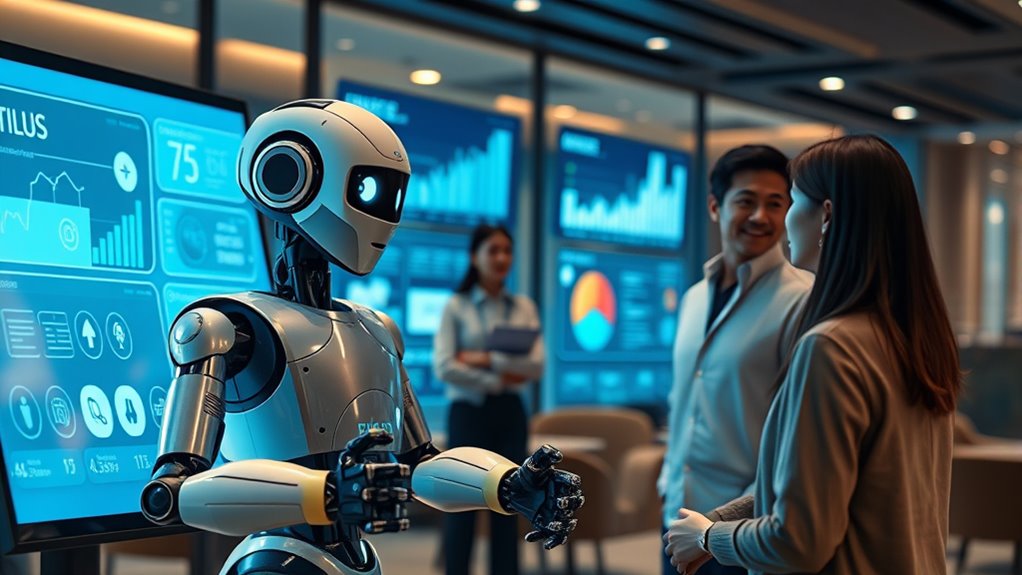Integrating automation into your customer experience allows you to deliver faster, more personalized service at scale. By using AI-driven insights, you can analyze customer data, segment audiences precisely, and tailor content automatically. This helps build stronger relationships while freeing your team for complex tasks. Automation enhances efficiency and engagement, creating a seamless journey for your customers. If you want to discover how to optimize this process further, there’s more you can learn to sharpen your strategy.
Key Takeaways
- Leverage AI-driven insights to personalize interactions based on customer behavior and preferences.
- Automate routine tasks like email campaigns and chat responses to improve efficiency and consistency.
- Use data analysis to refine automation strategies, optimizing messaging timing and content relevance.
- Balance automation with human interaction to enhance authenticity and deepen customer relationships.
- Continuously collect and analyze data to adapt automation efforts, ensuring a dynamic and targeted customer experience.

In today’s competitive landscape, integrating automation into customer experience isn’t just a trend—it’s a necessity. Businesses that harness automation tools can deliver faster, more tailored interactions that meet customer expectations and foster loyalty. One of the most effective ways to do this is through personalization strategies that leverage AI-driven insights. These insights help you understand your customers on a deeper level, allowing you to anticipate their needs and preferences with remarkable accuracy. Instead of relying solely on generic messages, you can craft targeted content that resonates, making each customer feel valued and understood.
Integrating automation with AI-driven insights creates personalized, efficient customer experiences that foster loyalty and engagement.
AI-driven insights play a pivotal role in shaping your automation approach. By analyzing data from various touchpoints—like website visits, purchase history, and social media activity—you gain a *thorough* view of customer behaviors and trends. This information enables you to segment your audience more precisely, ensuring that your automation efforts are relevant and impactful. For example, if a customer frequently browses a specific product category, your system can automatically send personalized recommendations or special offers related to their interests. This not only enhances their experience but also increases the likelihood of conversion.
Implementing automation with a focus on personalization means you’re continuously refining your strategies. As more data flows in, your AI tools become smarter, offering you *all-encompassing* insights that can inform your next move. You might discover that certain messaging resonates better at specific times of the day or that particular products are often bought together. Armed with this knowledge, you can automate personalized email campaigns, chat responses, or push notifications that feel natural and relevant. The result is a seamless experience where customers feel like they’re interacting with a brand that truly understands them.
Moreover, automation doesn’t replace the human touch; it amplifies it. With AI-driven insights, you can free up your team’s time from routine tasks to focus on more complex, value-added activities. Your customer service reps, for instance, can prioritize addressing nuanced issues or building deeper relationships, knowing that automated systems are handling basic inquiries and delivering personalized content. This combination of technology and human interaction creates a cohesive experience that feels both efficient and authentic.
In essence, blending automation with smart personalization strategies and AI-driven insights empowers you to create a customer journey that’s not only efficient but also deeply engaging. You’re no longer guessing what your customers want—you’re delivering precisely what they need, when they need it, in a way that feels personalized and genuine. Resources and Tools like localized legal expertise can also help tailor your approach to meet specific regional needs. That’s how automation elevates your customer experience from good to exceptional in today’s fast-paced digital world.
Frequently Asked Questions
How Does Automation Impact Personalized Customer Interactions?
Automation enhances your personalized customer interactions by enabling faster responses and tailored experiences. It boosts customer engagement through targeted messaging and relevant recommendations, making clients feel valued. With effective personalization strategies, automation helps you gather data to understand preferences better and deliver consistent, meaningful interactions. As a result, your customers enjoy seamless, customized service, fostering loyalty and satisfaction while streamlining your operations for greater efficiency.
What Are the Best Tools for Integrating Automation Seamlessly?
Think of automation tools as the artisans crafting your customer journey. To integrate seamlessly, choose platforms like Zendesk or HubSpot that allow robust chatbot customization and workflow optimization. These tools act like skilled artisans, tailoring interactions and streamlining processes. By selecting the right tools, you guarantee your automation feels natural, engaging, and efficient, transforming your customer experience into a well-orchestrated symphony that delights at every touchpoint.
How to Measure Automation Success in Customer Experience?
You can measure automation success in customer experience by tracking key automation metrics like response time, resolution rate, and customer satisfaction scores. Success indicators include reduced wait times, increased first-contact resolution, and positive feedback. Regularly analyze these metrics to identify areas for improvement, ensuring your automation tools effectively enhance the customer journey and deliver measurable results. This approach helps you optimize automation strategies for better overall experience.
What Are Common Challenges Faced During Automation Integration?
Imagine trying to teach a new dance move—you’ll face resistance and missteps. Similarly, during automation integration, you often encounter change management hurdles and employee training challenges. Resistance from staff, fear of job loss, and lack of understanding can slow progress. To succeed, you need clear communication, ongoing training, and patience. Addressing these challenges head-on guarantees smooth adoption and helps your team dance confidently into the future of customer experience.
How Does Automation Affect Customer Privacy and Data Security?
Automation can impact your customer privacy and data security by increasing the risk of data breaches if not properly managed. You should use data encryption to protect sensitive information and guarantee user consent is obtained before collecting or sharing data. By prioritizing these measures, you safeguard customer trust and comply with privacy regulations, making your automation efforts secure and respectful of user privacy.
Conclusion
As you weave automation into your customer experience, imagine a seamless dance where technology and human touch move effortlessly together. Picture your customers sailing smoothly through quick responses and personalized interactions, like a gentle breeze guiding them home. With automation as your trusted partner, you create a landscape where every touchpoint feels natural and inviting. Embrace this harmony, and watch your customers feel valued and understood—like a warm handshake in a busy world.









